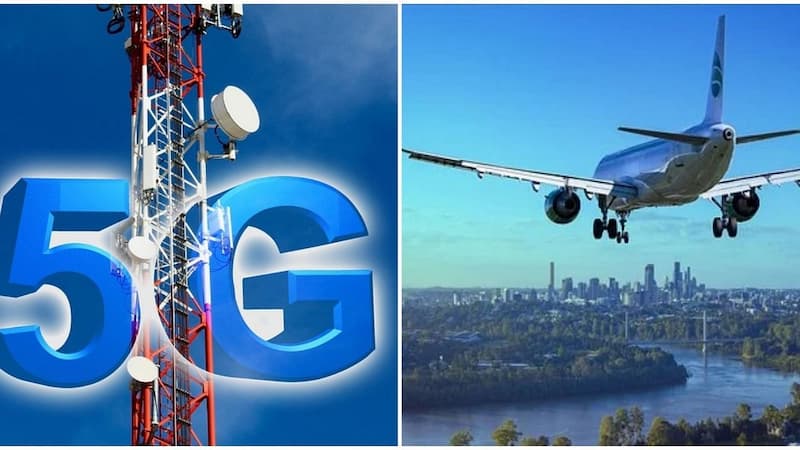How 5G interferes with aircraft signal is a report that shows how such interference will force pilots not to fly or land planes.
This is the stand of the US Federal Aviation Administration, FAA.
Meanwhile, telecommunications networks are rolling out next-generation (5G) systems.
In this article, you will about the following sub-headlines:
…Aircrafts that stand the risks the most
…How it affects 2,400 airplanes in the United States
…How it affects abut 8,300 worldwide
According to FAA, 5G will interfere with over 2, 400 airplanes in the US and 8, 300 airplanes worldwide.
Nigeria is known for purchasing the Boeing aircrafts and this kind of airplane stand the risk the most, FAA said.
Keep in mind that the world is looking at switching to the fifth generation network (5G) which promises faster internet speed.
This is among the greater speed in the transmissions that it promises.
ALSO READ: 3G Shutdown: Cars, Home Alarms, Medical Devices To Stop Working
Also, 5G brings about a lower latency and therefore greater capacity of remote execution.
Similarly, it supports greater number of connected devices and the possibility of implementing virtual networks (network slicing).
This will in turn provide more adjusted connectivity to concrete needs.
In simple analogy, 5G will allow you to download in seconds heavy files you ordinarily would use plenty minutes to download.
However, FAA has warned that wireless operations can interfere with radio altimeters and impede a crew’s ability to safely fly or land flights.
It explains how 5G affects flight signal and could impact sensitive airplane electronics such as radio altimeters.
Specifically, the regulator said 5G affects aircraft signal as it can negatively effect the Boeing 737 planes’ landings.
However, this does not apply to aircraft flying into safe areas where the 5G environment pose no danger.
Airports and aircrafts that will be affected:
All airports that have established 5G networks stand the risk.
FAA said specifically, aircrafts of the Boeing types stand greater risks.
Those that will be affected are Boeing 737 planes, including 747, 757, 767 and 777
jetliners.
How 5G interferes with aircraft signal:
With 5G network, certain airplane systems may not properly function “during approach, landings, and goarounds.”
This is due to interference with radio altimeters from wireless broadband operations in the 3.7-3.98 GHz
frequency band (5G C-Band).
Also, this in turn can lead to “increased flight crew workload while on approach with the flight director.”
Likewise, it can lead to workload while on approach with the flights autothrottle, or autopilot engaged.”
This could result in reduced ability of the flight crew to maintain safe flight and landing of the airplane,” said FAA.
Airports that won’t be affected:
However, airports that have either established 5G wireless buffer zones won’t face this risk.
Also, those that entirely lack 5G operations altogether will not also face the risk.
This means that planes landing in such airports are protected from radio interference.
Airports in Nigeria remain safe as the fifth generation network is yet to be installed at the airports.
5G deployed in Nigeria by NCC different from Civil aircraft altimeters – NIEE
Meanwhile, the Nigerian Institute of Electrical and Electronic Engineers (NIEE) has dispelled fears that the 5G deployed in Nigeria will interfere with aircraft signals.
According to a statement signed by its outgoing National Chairman, Kings Adeyemi, the NCC’s choice of the 3.5 GHz band is different from the civil aircraft altimeters, which usually operate between 4.2 and 4.4 GHz range.
He said, “This decision allays the fear of 5G services interfering with the aircraft operations as currently exercised in some countries.
“NCC’s choice on the 3.5 GHz band has sufficiently safeguarded civil aircraft altimeters, which usually operate between 4.2 and 4.4 GHz range.”
He commended the commission for the choice of 3.5-3.6 GHz and 3.7-3.8GHz as frequencies in the range 3.3-4.2 GHz (3GPP Band 78).
He said they are the basis for the first implementations of 5G globally.
Adeyemi said, “From expert’s perspective, the choice of two slots of 100 MHz (TDD) bandwidth each on 3.5 GHz band (precisely 3GPP Band 78) is a highly laudable.
He also lauds the choice to launch 5G network.
“It is technically proven that wider channels lower network density which ripples into lowering the cost of 5G services to consumers.
“Other advantages include less base stations sites and lower environmental impact.
“The 3.5 GHz band is the best choice to balance capacity and network coverage.
He said this is because it “encourages operators to commit investment in 5G infrastructure.”
Implications:
Federal authorities have continued to warn that 5G interferes with aircraft signal.
If this happens while a plane is mid-air, that could endanger the lives of passengers.
Also, it may disrupt people’s schedules as they will not fly on time nor land on time.
However, some experts have said 5G frequency bands are different from those of 5G.
Meanwhile, since 5G is still at early adoption stages, we wait to see if it actually affects aircraft signals.



















 and then
and then